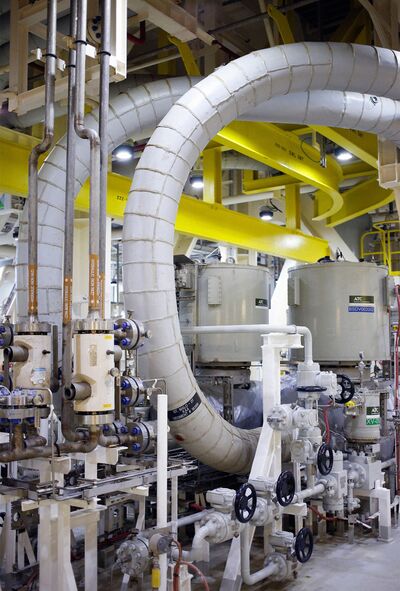The Washington Post – Opinion
Vote against the GOP this November
By George Will, Opinion writer June 22, 2018

House Speaker Paul D. Ryan (R-Wis.) meets with reporters at the Capitol on Thursday. (J. Scott Applewhite/AP)
Amid the carnage of Republican misrule in Washington, there is this glimmer of good news: The family-shredding policy along the southern border, the most telegenic recent example of misrule, clarified something. Occurring less than 140 days before elections that can reshape Congress, the policy has given independents and temperate Republicans — these are probably expanding and contracting cohorts, respectively — fresh if redundant evidence for the principle by which they should vote.
The principle: The congressional Republican caucuses must be substantially reduced. So substantially that their remnants, reduced to minorities, will be stripped of the Constitution’s Article I powers that they have been too invertebrate to use against the current wielder of Article II powers. They will then have leisure time to wonder why they worked so hard to achieve membership in a legislature whose unexercised muscles have atrophied because of people like them.
Consider the melancholy example of House Speaker Paul D. Ryan (Wis.), who wagered his dignity on the patently false proposition that it is possible to have sustained transactions with today’s president, this Vesuvius of mendacities, without being degraded. In Robert Bolt’s play “A Man for All Seasons,” Thomas More, having angered Henry VIII, is on trial for his life. When Richard Rich, whom More had once mentored, commits perjury against More in exchange for the office of attorney general for Wales, More says: “Why, Richard, it profits a man nothing to give his soul for the whole world . . . But for Wales!” Ryan traded his political soul for . . . a tax cut. He who formerly spoke truths about the accelerating crisis of the entitlement system lost everything in the service of a president pledged to preserve the unsustainable status quo.
Ryan and many other Republicans have become the president’s poodles, not because James Madison’s system has failed but because today’s abject careerists have failed to be worthy of it. As explained in Federalist 51: “Ambition must be made to counteract ambition. The interest of the man must be connected with the constitutional rights of the place.” Congressional Republicans (congressional Democrats are equally supine toward Democratic presidents) have no higher ambition than to placate this president. By leaving dormant the powers inherent in their institution, they vitiate the Constitution’s vital principle: the separation of powers.
Recently Sen. Bob Corker, the Tennessee Republican who is retiring , became an exception that illuminates the depressing rule. He proposed a measure by which Congress could retrieve a small portion of the policymaking power that it has, over many decades and under both parties, improvidently delegated to presidents. Congress has done this out of sloth and timidity — to duck hard work and risky choices. Corker’s measure would have required Congress to vote to approve any trade restrictions imposed in the name of “national security.” All Senate Republicans worthy of the conservative label that all Senate Republicans flaunt would privately admit that this is conducive to sound governance and true to the Constitution’s structure. But the Senate would not vote on it — would not allow it to become just the second amendment voted on this year .
This is because the amendment would have peeved the easily peeved president. The Republican-controlled Congress, which waited for Trump to undo by unilateral decree the border folly they could have prevented by actually legislating, is an advertisement for the unimportance of Republican control.
Trump’s policy of family separation was part of a broader pattern of attacks against immigrants and should never have existed, argues Elias Lopez. (Kate Woodsome , Gillian Brockell/The Washington Post)
The Trump whisperer regarding immigration is Stephen Miller, 32, whose ascent to eminence began when he became the Savonarola of Santa Monica High School . Corey Lewandowski, a Trump campaign official who fell from the king’s grace but is crawling back (he works for Vice President Pence’s political action committee), recently responded on Fox News to the story of a 10-year-old girl with Down syndrome taken from her parents at the border. Lewandowski replied: “Wah, wah.” Meaningless noise is this administration’s appropriate libretto because, just as a magnet attracts iron filings, Trump attracts, and is attracted to, louts.
In today’s GOP, which is the president’s plaything, he is the mainstream. So, to vote against his party’s cowering congressional caucuses is to affirm the nation’s honor while quarantining him. A Democratic-controlled Congress would be a basket of deplorables, but there would be enough Republicans to gum up the Senate’s machinery, keeping the institution as peripheral as it has been under their control and asphyxiating mischief from a Democratic House. And to those who say, “But the judges, the judges!” the answer is: Article III institutions are not more important than those of Articles I and II combined.
Read more from George F. Will’s archive
Read more:
Dana Milbank: Paul Ryan has been living in a cave
Jennifer Rubin: This is why Paul Ryan and the GOP need to be ‘discharged’

 A worker carries lumber as he builds a new home on January 21, 2015 in Petaluma, California. (Photo by Justin Sullivan/Getty Images)
A worker carries lumber as he builds a new home on January 21, 2015 in Petaluma, California. (Photo by Justin Sullivan/Getty Images)

 Pipes and mooring lines rise from the Gulf of Mexico beneath Chevron Corp.’s Jack/St. Malo deep-water oil platform about 200 miles off the coast of Louisiana on May 18, 2018. Photographer: Luke Sharrett/Bloomberg
Pipes and mooring lines rise from the Gulf of Mexico beneath Chevron Corp.’s Jack/St. Malo deep-water oil platform about 200 miles off the coast of Louisiana on May 18, 2018. Photographer: Luke Sharrett/Bloomberg Oil production equipment onboard Chevron’s Jack/St. Malo platform. Photographer: Luke Sharrett/Bloomberg
Oil production equipment onboard Chevron’s Jack/St. Malo platform. Photographer: Luke Sharrett/Bloomberg Platform supply vessel Kobe Chouest anchored alongside Jack/St. Malo. Photographer: Luke Sharrett/Bloomberg
Platform supply vessel Kobe Chouest anchored alongside Jack/St. Malo. Photographer: Luke Sharrett/Bloomberg Chevron workers examine hydrocarbon samples on Jack/St. Malo. Photographer: Luke Sharrett/Bloomberg
Chevron workers examine hydrocarbon samples on Jack/St. Malo. Photographer: Luke Sharrett/Bloomberg In this April 21, 2010, file photo, the Deepwater Horizon oil rig burns in the Gulf of Mexico following an explosion that killed 11 workers and caused the worst offshore oil spill in the nation’s history. President Donald Trump is throwing out a policy devised by his predecessor for protecting U.S. oceans and the Great Lakes, replacing it with a new approach that emphasizes use of the waters to promote economic growth. President Barack Obama issued his policy in 2010 after the Deepwater Horizon oil spill in the Gulf of Mexico. Trump says it was too bureaucratic. (AP Photo/Gerald Herbert, File)
In this April 21, 2010, file photo, the Deepwater Horizon oil rig burns in the Gulf of Mexico following an explosion that killed 11 workers and caused the worst offshore oil spill in the nation’s history. President Donald Trump is throwing out a policy devised by his predecessor for protecting U.S. oceans and the Great Lakes, replacing it with a new approach that emphasizes use of the waters to promote economic growth. President Barack Obama issued his policy in 2010 after the Deepwater Horizon oil spill in the Gulf of Mexico. Trump says it was too bureaucratic. (AP Photo/Gerald Herbert, File) Getty Images
Getty Images